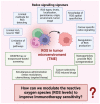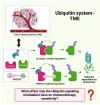Targeting the Interplay of Independent Cellular Pathways and Immunity: A Challenge in Cancer Immunotherapy
- PMID: 37296972
- PMCID: PMC10252254
- DOI: 10.3390/cancers15113009
Targeting the Interplay of Independent Cellular Pathways and Immunity: A Challenge in Cancer Immunotherapy
Abstract
Immunotherapy is a cancer treatment that exploits the capacity of the body's immune system to prevent, control, and remove cancer. Immunotherapy has revolutionized cancer treatment and significantly improved patient outcomes for several tumor types. However, most patients have not benefited from such therapies yet. Within the field of cancer immunotherapy, an expansion of the combination strategy that targets independent cellular pathways that can work synergistically is predicted. Here, we review some consequences of tumor cell death and increased immune system engagement in the modulation of oxidative stress and ubiquitin ligase pathways. We also indicate combinations of cancer immunotherapies and immunomodulatory targets. Additionally, we discuss imaging techniques, which are crucial for monitoring tumor responses during treatment and the immunotherapy side effects. Finally, the major outstanding questions are also presented, and directions for future research are described.
Keywords: cancer; immunotherapy; immunotherapy-challenges; immunotherapy-limitations.
Conflict of interest statement
The authors declare no conflict of interest.
Figures








References
-
- Darvishi M., Tosan F., Nakhaei P., Manjili D.A., Kharkouei S.A., Alizadeh A., Ilkhani S., Khalafi F., Zadeh F.A., Shafagh S.G. Recent progress in cancer immunotherapy: Overview of current status and challenges. Pathol. Res. Pract. 2023;241:15424. - PubMed
Publication types
Grants and funding
LinkOut - more resources
Full Text Sources

